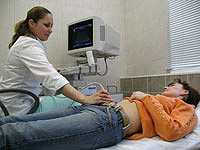How to diagnose apoplexy of the ovary? What are the methods of treating apoplexy of the ovary? Answers to these questions you will find in the article.
Content
According to the literature, the correct clinical diagnosis of the apoplexy of the ovary is only 4-5%.
Diagnostic errors are explained primarily with the fact that the clinic
This disease does not have a characteristic picture and develops by type
other acute pathology in the abdominal cavity and small pelvis.
The patient will bring in the hospital with a diagnosis «Acute belly». Clarification Causes is carried out in the hospital.
First of all, the apoplexy of the ovary must be differentiated from ectopic pregnancy and acute appendicitis.
As a rule, in the case of a clinic «acute belly» Also need consultation of related specialists (surgeons, urologists).
Since the apoplexy of the ovary is acute surgical
pathology, the diagnosis must be put very quickly, since
Increased time before the operation leads to an increase in the magnitude
blood loss and maybe a life threatening condition!
The most informative methods of research are:
 Characteristic complaints about sharp abdominal pains that appeared in the middle or second half of the menstrual cycle.
Characteristic complaints about sharp abdominal pains that appeared in the middle or second half of the menstrual cycle.
- At
examination marked pronounced pain from the affected
ovary, and also become positive symptoms of peritonean irritation.
- In general blood analysis, a decrease in hemoglobin level (with anemic and mixed formations of ovarian apoplexy).
- Plug of the rear axle, allowing to confirm or disprove the presence of intra-abdominal bleeding.
- Ultrasonic
study that allows you to see in the affected ovarian big
Yellow body with signs of hemorrhage into it and / or loose fluid
(Blood) in the stomach.
- Laparoscopy, which allows not only 100% diagnosed, but also make correction of any pathology.
The final diagnosis of the apoplexy of the ovary is almost always installed during the operation.
Your actions in apoplections are necessary:
- Take a horizontal position.
- Urgently call an ambulance for hospitalization in surgical or gynecological hospitals.
Methods for treating apoplections of ovary
- Conservative treatment is possible only in the case of a light form of apoplexy of the ovary, which is accompanied by minor bleeding in the abdominal cavity.
Patients with a light form of apoplexy make complaints first of all on pain at the bottom of the abdomen.
However, the data of many researchers prove that
Conservative maintenance of such patients in 85.7% of cases in a small pelvis
Spikes are formed, and 42.8% of cases are registered infertility.
Almost every 2nd woman after conservative maintenance may have a relapse (repeated apoplexy of the ovary). This is due to the fact that blood and clots, which accumulate in the abdominal cavity after the ovarian break (apoplexy),
do not wash like with laparoscopy, remain in the abdominal cavity, where
organized and contribute to the formation of the adhesive process in a small pelvis.
Conservative treatment can only be recommended for women, already
implemented their reproductive function (that is, already having children and
do not plan to have them) in case of detection of them light shape
apoplexy ovarian.
If a woman is in reproductive age and plans
pregnancy, then tactics even in the case of a light form of apoplexy of the ovary
must be revised in favor of laparoscopy.
- Surgical treatment is basic because not only allows you to clarify the diagnosis, but also to carry out a full correction.
In all cases of apoplexy, laparoscopy is possible! Single contraindication to using this access
is hemorrhagic shock (that is, very large blood loss with
loss of consciousness). The operation must be launched as a gentle way to conservation of the ovary. As a rule, the cyst capsule is removed, coagulation or
Surifying ovarian. In rare cases with massive hemorrhage
Removal of ovarian removal required. During the operation, it is necessary to wash the abdominal cavity thoroughly,
Remove clots and blood, for the prevention of adhesions and infertility.









